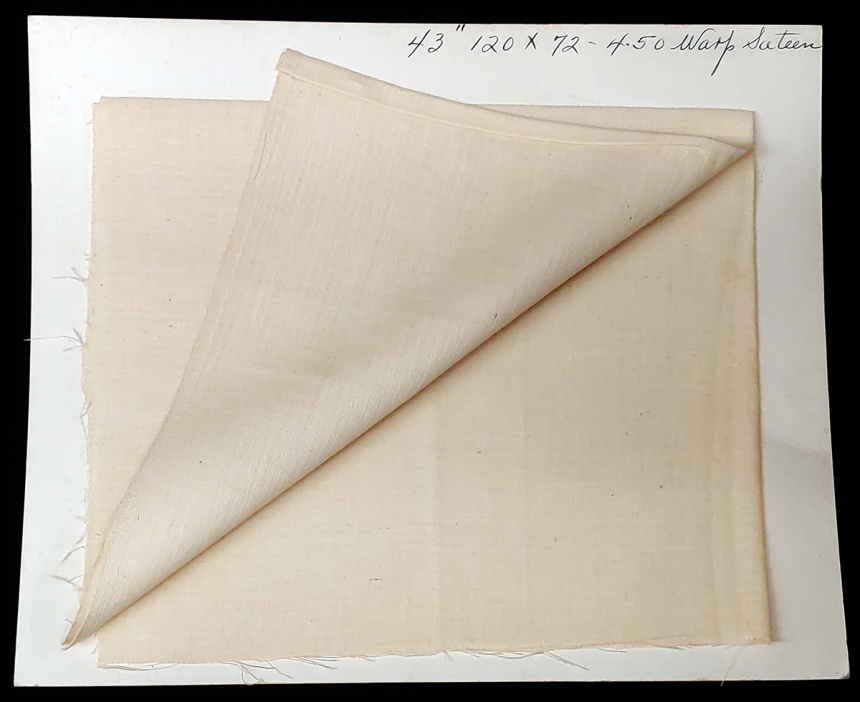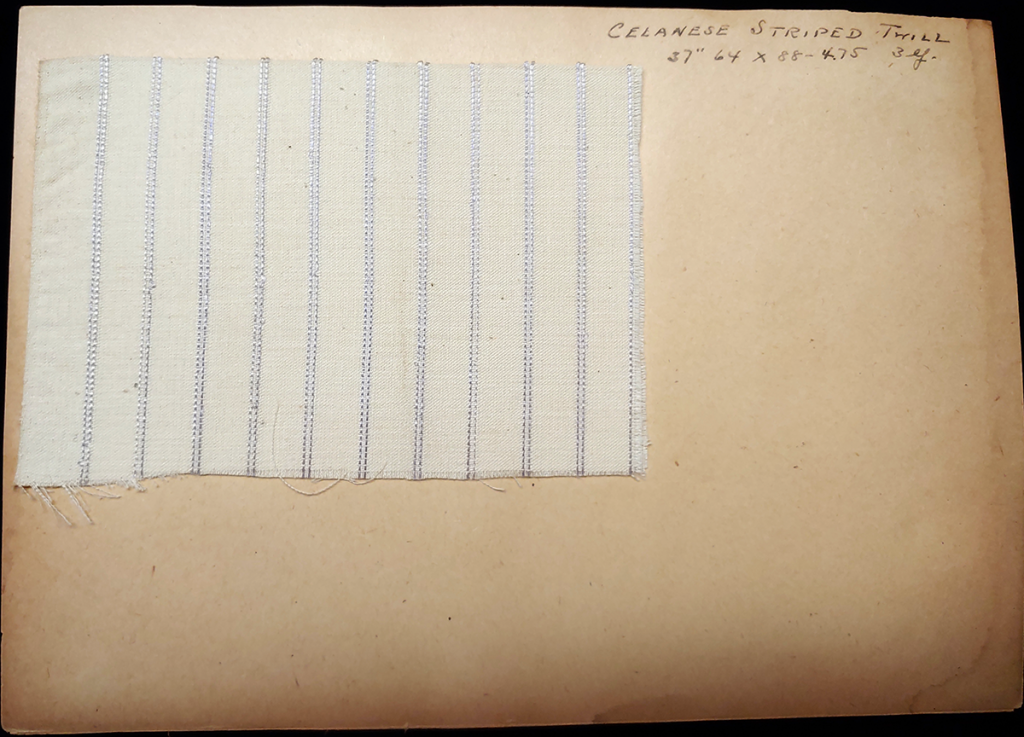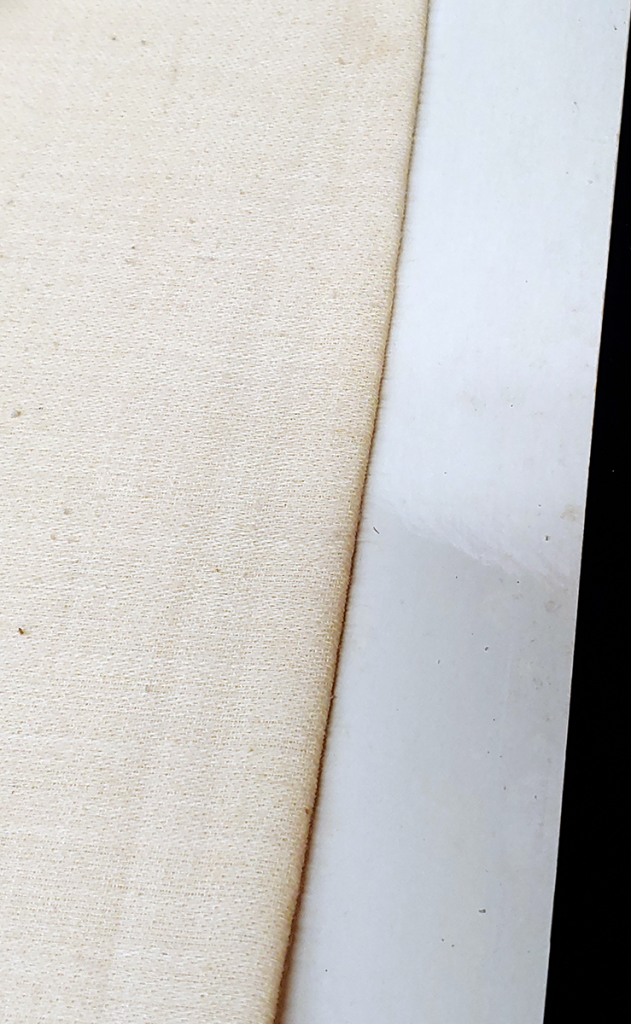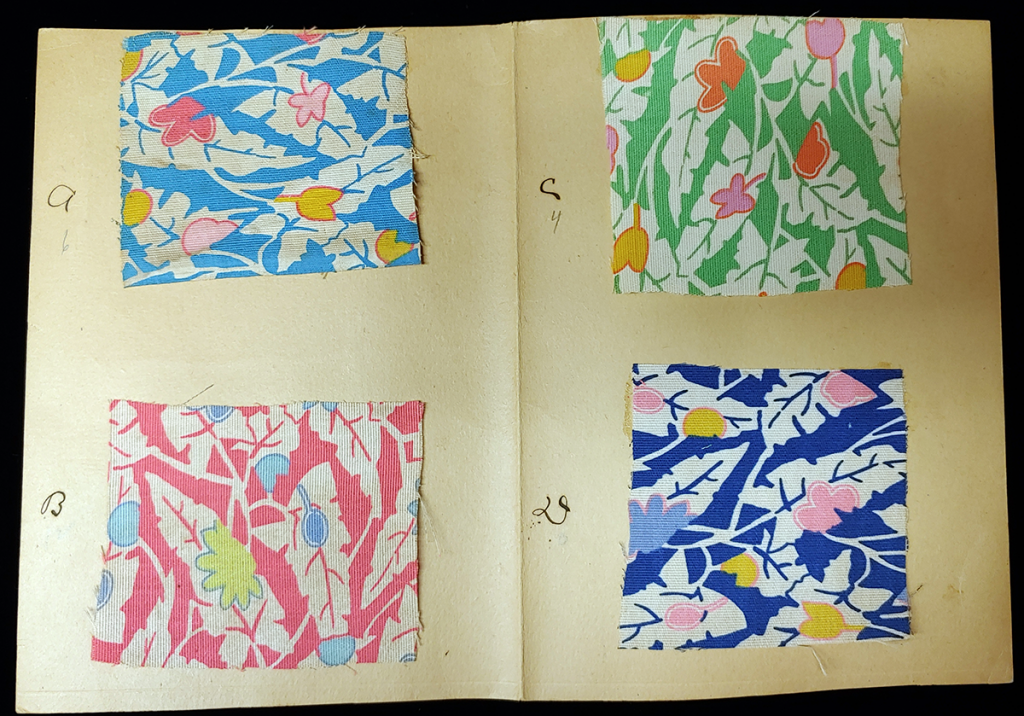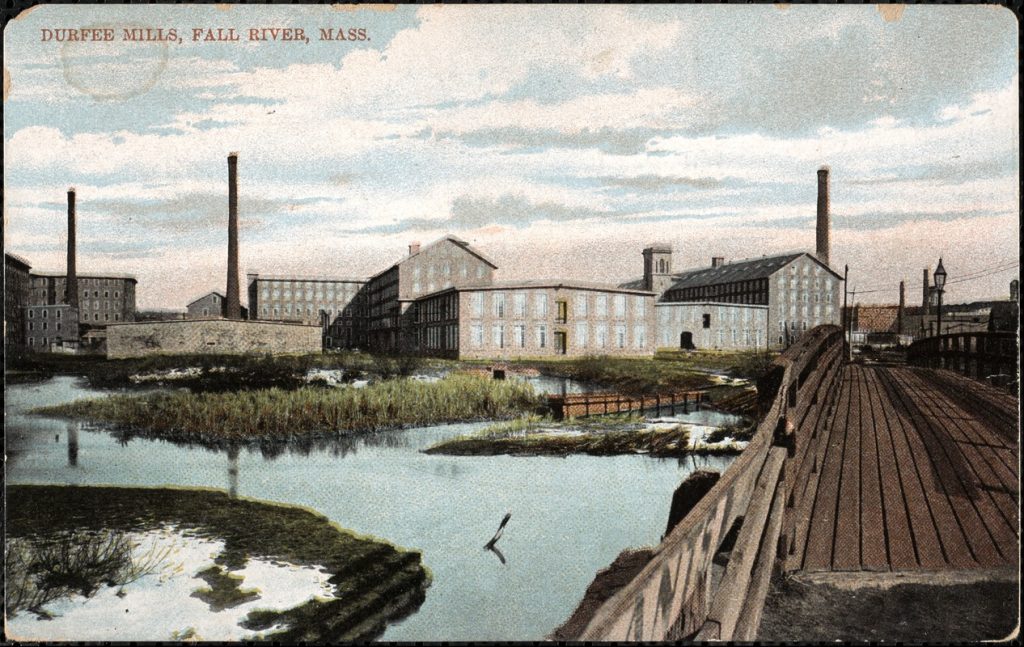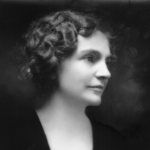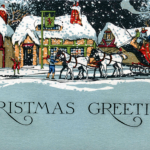Of the countless miles of cloth woven or printed in Fall River’s mills during the nineteenth and twentieth centuries, surprisingly few samples have survived with documentation of their production origin and date. The FRHS has maintained the largest collection extant, with several hundred examples that were manufactured in the city from the inception of the industry through the mid-twentieth century.
Recently, a significant collection of textile swatches – 247 samples mounted on 141 cards, woven at the Durfee Mills in Fall River and dating to the 1920s – were acquired by the FRHS. The donor had no definite idea as to how they came into her possession, having discovered them when cleaning out a storage area in a family home. Evidenced by the presence of heavy surface soiling, grit, and the occasional insect carcass – long dead, thankfully, and rather desiccated – they had clearly been there for some time.
What makes this collection particularly interesting is that each swatch is accompanied by detailed handwritten production notes, including, in many cases, dates of manufacture – 1923 to 1929 – and the identity of the firm for which it was produced.
The samples include a variety of goods woven by the Durfee Mills during that period: Bengaline; Celanese; Curtain Cloths; Dimity; Dobbies – cotton, rayon, and rayon-filled; Lawns; Napping Cloth; Plain Cloth; Poplin; Prints; Rayon Filled – alpaca, plain, sateens, and twills; Rayon Crepes; Sateens; Shirting’s; Ticking; Tobacco Cloth; Tussah Silk Filled; Twills ; and Voiles. A diverse output, for sure.
The fabrics – and their 1920s uses – loosely defined:
- Bengaline: A firm, closely woven fabric with fine ribs spaced at intervals running across the fabric. This was considered suitable for women’s dresses, men’s shirts, and curtains.
- Celanese: A trade name for an artificial silk fabric that was marketed world-wide as being very easy to clean. The name was a combination of “cellulose” and “ease,” and was introduced by The American Cellulose & Chemical Manufacturing Company (Amcelle) in 1925; in 1927, they became the Celanese Corporation of America. The fabric was widely used for women’s clothing, due to its superb draping quality, but was also woven into more durable fabrics, such as twill.
- Curtain Cloth: The name says it all. Sheer, lightweight fabric of various types used for window treatments. This was often referred to as “Glass-curtain fabric,” so named because it was hung closest to the window glass.
- Dimity: A sheer, crisp, corded fabric that is mercerized, producing a soft luster. It was suitable for a wide range of clothing – dresses, blouses, and lingerie, was used in lampshade production, and for table runners, napkins, and curtains.
- Dobbies – cotton, rayon, and rayon filled: Dobbies are fabrics woven with textured or geometric patterns, suitable for a wide range of uses, from clothing to household goods. Rayon is a manufactured fiber made from modified cellulose that was made from natural sources – it was not considered synthetic, because of its natural derivative.
- Lawn: A lightweight, sheer, fine fabric, woven in a high thread count, treated for a soft, or a crisp finish. This was used for women’s and children’s clothing and curtains.
- Napping Cloth: A fabric of various weaves and weights, with a texture napped to different grades for added warmth – think flannel.
- Plain Cloth: Fabrics woven with a plain weave; these multiple-use fabrics were considered the simplest of all cloth woven during the period.
- Poplin: A lightweight, firm, finely ribbed fabric, with ribs running across the surface; it has the finest ribs of all ribbed fabric and was used for a wide range of clothing.
- Prints: As the names implies, this fabric – of various types, weights, and uses – was manufactured to be printed.
- Rayon Filled – alpaca, plain, sateens, and twills: Alpaca is a plain woven fabric that was often used for linings; the name is misleading, as it contained no alpaca.
- Rayon Crepes: A fabric woven with highly twisted rayon yarns ranging from smooth surface texture to a highly crinkled, pebbly surface. This had a wide range of uses, and was a popular choice for women’s dresses.
- Sateen: A lustrous, smooth fabric of various weights. This cloth had multiple uses, including clothing and household goods.
- Shirting: A fine fabric – of various weights and textures – used as the name implies.
- Ticking: A closely woven, durable fabric. Used for mattress covers, pillow covers, and upholstery.
- Tobacco Cloth: A very loosely woven fabric in a low thread count – think cheesecloth, because it is the same thing.
- Tussah Silk Filled: A course fabric of irregular weave, manufactured from raw silk that originated from wild silk worms; it was often combined with cotton or rayon yarns. During the 1920’s it was a popular choice for dresses and draperies.
- Twill: A versatile, durable fabric characterized by diagonal ribs woven in many variations and textures, such as herringbone or zigzag. This had a wide range of uses, from clothing to household goods.
- Voiles: A sheer, open weave fabric that is lightweight, transparent, and softly draping. It was used for women’s and children’s clothing, curtains, and bedding.
The swatches were mounted in a classic “make-do” manner and affixed to repurposed file folders or scraps of pasteboard cut to roughly 11.5 x 9 inches. The cards appear to have been removed from their original location and deposited into a box where they remained for decades; fortunately, several were in order by type and style number, with header divider cards in situ, making reassembling the collection for cataloguing easier. Others had been sorted through and were somewhat disheveled, making that process a bit more involved.
The most time-consuming undertaking was the multi-step cleaning process. Each card was surface treated with archival dry cleaning pads to remove accumulated soiling; the swatches were carefully vacuumed through fiberglass screening to lift grime and accumulated debris – the screening ensures even surface stability and prevents the unraveling of loose threads; and fabric creases were relaxed using distilled steam. Finally, the cards were individually placed in archival 3mil clear polyester envelopes and stored in acid-free boxes.
The collection, now fully cleaned, stored in archival material, and catalogued, furnishes important primary source material for scholars and students of textile studies.
We will never know the full particulars of the manner in which the collection made its way from the offices of the Durfee Mills to storage in the donor’s family home – the likely scenarios are many. I suspect – just a thought – that someone was reusing an old filing cabinet, found the samples in one of the drawers, and deposited them into a box where they sat, relatively undisturbed, for many a year.
Fortunately, the donor had a hunch that the samples might have historical significance and the foresight to contact the FRHS to see if the museum was interested.
One caution though:
“They’re kind of grubby.”
A visit to the FRHS shortly thereafter and a quick glance by yours truly:
“Yes, we would like to have them for the collection.”
In fact, this donation represents the largest collection of textile samples produced by a single mill in Fall River that has ever been acquired by the FRHS.
In some ways, they have gone full circle and have come home.
Members of the Brayton family that once resided in the building that now houses the FRHS museum and library owned and operated the Durfee Mills.

